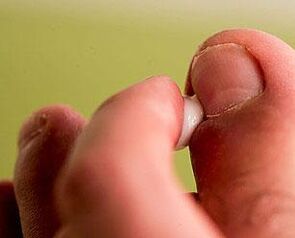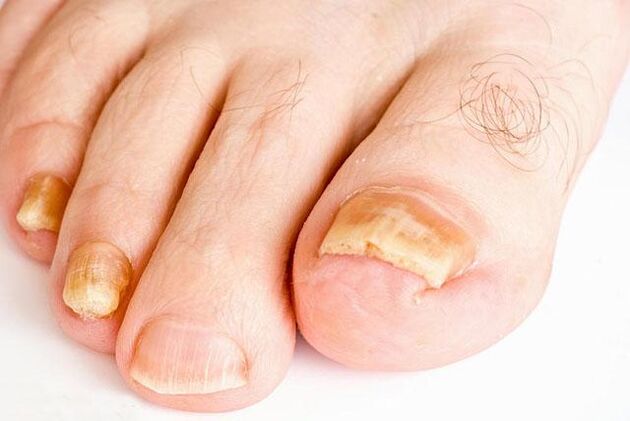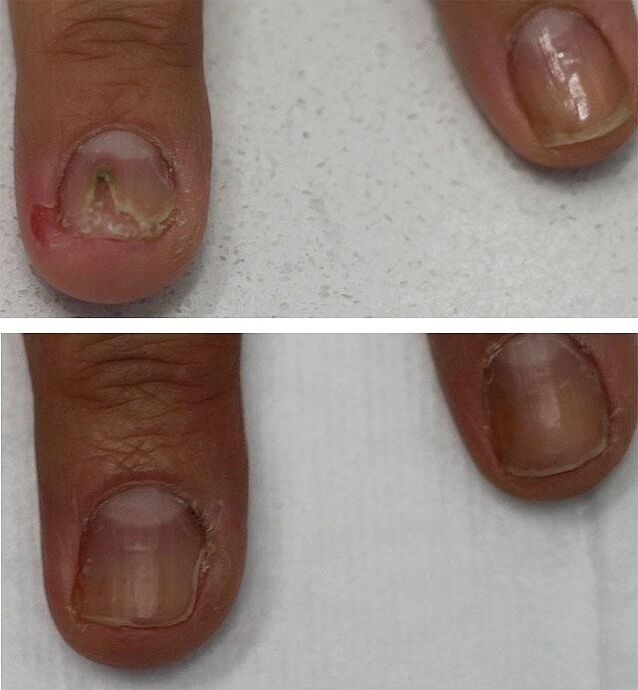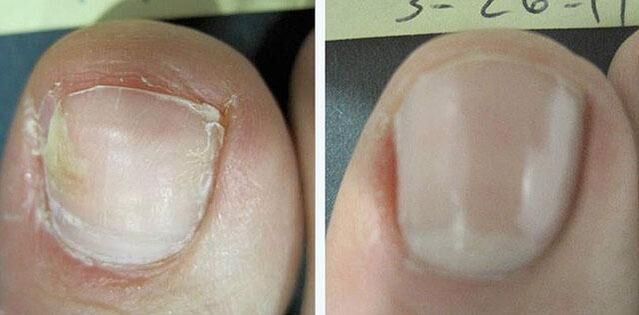
Onychomycosis is a widespread (up to 18% of the population) fungal nail disease. It affects people of all ages, and an increase in the number of people affected over the past decade has also been noted among adolescents and children. Due to high contact and frequent recurrence, the treatment of nail fungus on the hands and feet is complicated and time consuming.
When does the infection occur?
- In families with commonly used shoes, household items (carpets in the bathroom) and body care products (clothes, manicure sets);
- While visiting swimming pools, gyms and businesses, saunas and showers in baths.
The causative agents of the disease
Effective treatment of nail fungus is possible only with the correct laboratory diagnosis of the pathogen. Onychomycosis is caused by various types of dermatophytes in almost 90% of cases. A special type affects the appropriate parts of the body that are characteristic of it:
- toenails and hands, as well as any part of the skin;
- the nail plates on the feet and the skin of the III-IV interdigital spaces, the arch of the foot, the upper third of the sole, the lateral surfaces of the toes.
More rarely, the disease is caused by other fungi - trichophytos, epidermophytos, to a lesser extent - yeast. In very rare cases, onychomycosis can be caused by molds that affect the nails in the area of the first toes, mainly in people over 50 years of age.
Contributing factors
Favorable conditions for the application and development of infection:
- Damage to the nail plate and surrounding skin. This often occurs as a result of cosmetic procedures, do not wear tight shoes.
- The bones of the toes and feet or hands.
- Swelling of the legs with heart disease, atherosclerosis of the lower extremities, varicose veins, Raynaud's disease (spasms of the vessels of the upper extremities).
- Endocrine diseases (especially diabetes mellitus).
- Pregnancy (due to hormonal changes and decreased immunity).
- Decreased general immunity.
- Congenital anomalies in the formation of the stratum corneum of the skin.
- Severe and long-term chronic diseases that reduce the body's defenses.
- Long-term treatment with corticosteroids and antibiotics, systemic and other immune diseases.
The possibility of infection in the blood and lymph in the body itself has already been proven.
Diagnosis of onychomycosis
The diagnosis of a fungal infection is based on local and general clinical manifestations and laboratory studies.

Clinical manifestations
The symptoms are very different and depend on the type and type of pathogen. Separately, toenails (80%) and hands may be affected; less common is the simultaneous defeat of the nails of the lower and upper extremities.
According to the nature of the change in the nail plate, there are 4 forms of damage:
- Normotrophic- characterized by yellowing of the last edge of the nail plate. The epidermal stratum corneum (subungual hyperkeratosis) becomes dull and thick. The shape of the affected nails does not change for a long time.
- Hypertrophic, the nail is yellowish and thickened, the edges are loosened. Transverse striae appear gradually. The nail plate becomes dirty gray and pale. In some cases, it thickens (usually in the first legs), is long and curved like a bird's claw or beak (onychogryphosis).
- Atrophic- nails are pale, gray or yellow. They change their shape, collapse at the end, partially exposing the bed. Second, the stratum corneum is covered with loose layers.
- Onycholysis- Separation of the nail plate from the bed. With this fungal infection, the normal color remains only in the root area. The rest of the nail thins, separates from the bed, loses its luster and becomes yellowish or gray-dirty.
Combined forms are often observed. The listed clinical manifestations are not specific for specific types of fungal lesions. They can also occur in diseases not related to fungi.
Some common manifestations are also possible: allergic rash, increased fatigue and decreased appetite. This is due to the ability of some types of dermatophytes to cause allergic remodeling of the body and the release of mold fungi - toxins and chronic intoxication of the whole body.
Laboratory diagnostics
Consists of material accumulation (particles of epidermal layers, nail fragments). The resulting material is poured into a caustic alkaline solution, left for 24 hours at a temperature of about 20 degrees, and then examined under a microscope. This technique allows to make a differential diagnosis between fungal and non-fungal lesions. A fungus, fibers of different thickness and shape, spore groups appear under a microscope.
After that, the material for the growth of the pathogen is planted in a special nutrient medium, then the type is determined and susceptibility to antifungal drugs is determined.
Treatment features
The choice of therapy takes into account the form, type and degree of the lesion, the rate of nail growth, the general condition of the body and the side effects of the drugs used, especially the presence of concomitant diseases. Based on these principles, the treatment of nail fungus and hands consists of a local or complex effect.
Principles of Local Impact
Possible:
- the infection did not affect all the nails;
- the defeat of each of the infected nail plates is less than half the area;
- the process is located only at the tip and sides of the plate, without including the root;
- There are contraindications to the use of systemic drugs.
Local drug treatment
It consists of the use of a cream, solution or nail polish that contains ingredients that soften the nail plate. Also included are medications to treat nail (hand) fungus that stifles the growth and development of the infection:
You can pre-apply any preparation to soften the plate and remove the layer as in the first case, and then apply a broad-spectrum antifungal drug in the form of a cream or solution 2 times a day. At the same time, they should be rubbed into the surrounding skin.

Medical device pedicure
A medical pedicure is used (but not a cure! ) As an additional procedure to shorten the treatment period. Its essence is to use a guide with an attachment in the form of a metal or diamond cutter. This device makes it very easy to remove a previously softened nail bed painlessly. When more than 60% of the nail plate is damaged, it is advisable to use the apparatus method, but it does not replace medication with antifungals.
Surgery
In severe forms of onychomycosis with severe deformity of the nail, it is sometimes surgically removed under general anesthesia or conductive anesthesia with the use of antifungal drugs. The main disadvantage of the method is the damage to the nail bed, as a result of which the newly grown plate is left behind and has an irregular shape.
Laser treatment
This method involves warming the nails with laser radiation at a temperature of 45-47 degrees for a short pulse, at which the dermatophytes die. The procedure is most effective in the early stages of deformed nail damage. Depending on the severity, 1 to 8 sessions should be performed between 7 and 60 days. Severe lesions should be treated locally and systemically.

Systemic drug treatment
It is indicated in the absence of numerous damage to the nails, the involvement of the root in the process and the effect of local exposure.
The most effective drugs for the treatment of nail fungus are tablets. substances containing terbinafine, fluconazole and others. They are prescribed in courses for 3-4 months and remain in the body for up to 9 months after the end of treatment. The last two drugs are less commonly used due to their toxic effects on the liver.
Systemic treatment is contraindicated in kidney and liver disease. Local treatment of only 1-2 nails is possible during pregnancy and lactation, but it is better to avoid it.
























